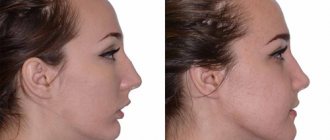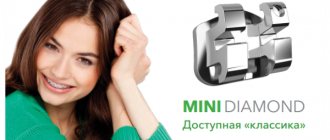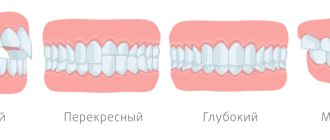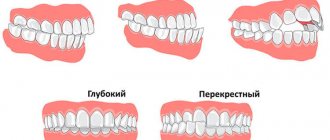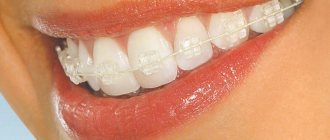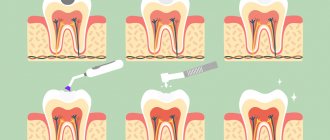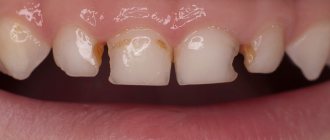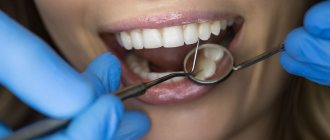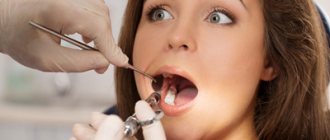Most people associate modern orthodontics with the word “braces,” and this is no coincidence. Today, the braces system is perhaps the most common and popular orthodontic device. What is modern orthodontics, what opportunities and prospects does it open for patients? We will try to figure this out, talk about it and answer the questions that patients most often ask when they come for a consultation with an orthodontist.
“At what age is it best to correct the bite?” - parents usually ask when bringing their child for a consultation. The optimal time to start orthodontic treatment is determined individually for each patient by an orthodontist.
In most cases, the ideal age for this is 10-12 years old. Because this is the time of active growth of the child, the final stage of bite formation, during which medical intervention gives the most rapid and beneficial effect.
However, there are situations when orthodontic treatment must begin at an earlier age, immediately when a problem is detected, and sometimes, on the contrary, it is better to postpone the intervention until the patient’s growth is complete, i.e. up to 17-18 years old. When choosing the time for starting treatment, the following are taken into account: the type of dental anomaly (i.e., type of bite), the degree of its severity, the condition of the tooth enamel, the level of oral hygiene, the general/physical development of the patient, his desire or reluctance to wear an orthodontic apparatus, and many others.
— it is advisable to show the child to an orthodontist for the first time at the age of 4 years, when the primary bite is fully formed. The doctor will determine whether there are problems or not, explain when and why they need to be solved, and give the necessary recommendations.
— I also consider it necessary to note the fact that modern treatment methods allow for high-quality alignment of teeth and bite at any age, if the patient needs it - this is confirmed by the many years of experience of most orthodontists.
The so-called early orthodontic treatment corresponds to the age of a child between 5 and 10 years.
At this age, various designs of removable “plates” and modern elastic aligners – trainers – are widely used as orthodontic appliances. During this period, non-hardware treatment and preventive measures are effective, such as:
— myogymnastics — special exercise programs to normalize the function of the muscles of the tongue, lips, cheeks;
- surgical interventions - sequential removal of baby teeth to create space in the dental arch, plastic surgery of the frenulum of the tongue, lips;
- massage of teeth during their eruption, to correct the direction of growth;
— selective grinding of baby teeth.
Proper implementation of such measures helps to fully or partially normalize the bite and improve, that is, create more favorable conditions for the further formation of the bite and growth of the child’s jaws. However, despite the presence of undeniable advantages, early treatment does not exclude or replace orthodontic treatment in adolescence, but is only a preparatory stage, helps to shorten the duration of treatment and reduce the amount of intervention at an older age. It should also be remembered that, regardless of the age at which treatment began, it can be considered complete only when the permanent teeth have completely erupted - by the age of 14 - 15 years. That is, treatment can last from 5 - 6 years to 14 - 15, and such an increase in the duration of wearing various orthodontic structures can have certain negative consequences for the child. Therefore, early treatment should only be started if there is a compelling reason to do so.
Dangers of malocclusion
It would seem like a small thing: the teeth protrude slightly or do not close together. But the human body is a single apparatus. Improper functioning of one part leads to failures in others. The dental system is involved in the process of chewing, breathing, swallowing and speech.
Breath
Pathologies of the jaws lead to the fact that a person begins to breathe through the mouth. In children, this leads to insufficient lung volume and frequent diseases of the upper respiratory tract.
When breathing through the mouth, less oxygen enters the lungs, and the chemical composition of the blood changes. This leads to the development of pulmonary and cardiovascular diseases.
Chewing
With a correct bite, the chewing load is distributed evenly. If the occlusion is incorrect, some teeth are excluded from the process, and the remaining ones are subject to additional stress. This leads to tooth decay and periodontal disease. Also, improper load when chewing eliminates some of the muscles, which can provoke problems with the TMJ (maxillary joint)
Swallowing
One of the functions of the tongue is to push food from the mouth into the larynx and beyond. With an incorrect bite, the tongue is positioned incorrectly in the mouth, resting not on the palate, but on the teeth. Due to this, it does not work at full strength, is placed between the teeth, and complicates the orthodontic situation in the mouth.
Speech
With abnormal occlusion, pronunciation suffers the most. The child cannot pronounce some sounds, swallows them, and replaces them with others. It is difficult to understand such children; their diction is impaired and their speech is unintelligible.
During a conversation, certain muscle groups work. With pathologies, some of them are switched off from the process, others are overexerted. This can lead to facial asymmetry.
Posture
Relatively recently, doctors began to pay attention to the relationship between bite and posture. An incorrect bite affects the position of the head. And this, in turn, shifts the center of gravity. The load on the spine changes and back problems, scoliosis and other troubles appear.
Orthodontic treatment in adolescence (11 - 12 years).
This is the most favorable period for orthodontic intervention, since it coincides with the period of active growth of the child and therefore the solution to most bite problems occurs more quickly and efficiently. The main orthodontic device at this age is the braces system. Since the braces system is a non-removable device and the patient wears it on the teeth throughout the entire treatment period, it is very important to pay great attention to oral hygiene and carry out preventive measures aimed at strengthening the structure of the tooth enamel in order to prevent the occurrence of caries and the so-called “white spots” around braces .
Smile in a Million
— It turns out that lingual braces are the most comfortable?
- I wouldn't say that. Lingual braces have the advantage that they are not visible, but from a therapeutic point of view this is a more labor-intensive and complex process. And, if it is not important for the patient which braces to fix, I will recommend him new generation braces - Damon 3 - System. They are quite aesthetic because the half of the bracket is transparent and there is no ligature, reduced size of the bracket, low friction forces in the system, less traumatic effect on the moved teeth and surrounding tissues, which greatly reduces the duration of treatment, less pain, more comfort for the patient, which generally improves the quality and effectiveness of treatment. Now modern technologies are emerging that allow the use of a lingual system, manufactured individually for each patient in a special laboratory. - But it probably costs much more? - More expensive or cheaper - the concepts are very vague. Everyone decides this for themselves. If parents try to cure their child, to give him a beautiful smile for life, they do not save, but, on the contrary, invest in their child, in his comfort, in his future. Otherwise, a complex person may grow up, embarrassed to say a word, hiding his smile... A beautiful smile is a psycho-emotional factor, a health factor, and a social factor. Investment in orthodontic treatment is the best investment in life, health, beauty, image, individuality. The leading role in a person’s appearance belongs to the face, and on the face – a smile. If it is believed that the eyes are the mirror of the soul, then a smile is a reflection of the heart. Back
Orthodontic treatment of adult patients (over 18 years old).
Modern methods of orthodontic treatment make it possible to achieve high-quality and stable results, regardless of the patient’s age. However, straightening teeth and correcting bites in adults has its own characteristics and is fundamentally different from pediatric and adolescent orthodontics.
Unfortunately, with age, the condition of teeth and gums worsens. Problems appear such as: an increase in the number of filled, pulpless teeth, the loss of some of them, the appearance of periodontitis - a chronic disease of the gums and tissues surrounding the teeth. Finally, the general condition of the body does not improve over the years. All this can negatively affect the quality, volume and the very possibility of orthodontic intervention. Therefore, to solve aesthetic and functional problems in adult patients, the orthodontist requires joint work with doctors from other dental specialties: periodontist, therapist, surgeon, orthopedist.
In addition to improving the aesthetics of the face and smile, orthodontic treatment in adults solves a number of other problems, such as:
— alignment of tilted teeth and thereby creating optimal conditions for high-quality prosthetics and implantation;
— eliminating crowding of teeth and normalizing the bite improves oral hygiene and makes periodontal treatment more effective;
- in some cases (for example, with periodontitis), preliminary straightening of the teeth and their subsequent splinting - that is, strengthening, connecting with each other, is the only way to preserve the patient’s own teeth.
Types of bite
Bite is the closure of the teeth of the upper and lower jaw. Orthodontists call it occlusion.
There are several parameters by which a bite is classified as correct or incorrect. When making a diagnosis, take into account:
- how much the upper teeth overlap the lower teeth;
- how teeth contact each other;
- at what angle they are located;
- presence of antagonists (teeth opposite);
- How is the central axis located?
When these indicators do not correspond to the norm, they speak of a malocclusion.
- Only 10% of the population has a correct bite, but most people have minor anomalies and do not pay attention to them. This leads to sad consequences. Malocclusion has a negative impact on the quality of life: the chewing load is distributed unevenly, difficulties arise with prosthetics, inflammatory processes develop in the periodontium, and posture is disturbed.
What is better - braces or a plate?
There is an opinion that a brace is just an improved plate, only more fashionable and expensive. This is fundamentally wrong. The goals and objectives for which braces and plates are created are different.
Firstly, the age at which plates are used is limited (up to 11-12 years), and they are placed mainly on baby teeth, braces - only on permanent ones, and for people of any age.
With the help of a plate, the orthodontist can save a young patient from bad habits that can subsequently adversely affect the position of permanent teeth: for example, thumb sucking or inserting the tongue between the teeth. Plates can help a child with malocclusion. They are able to widen a jaw that is too narrow and correct the position of some teeth - in cases where this needs to be done at an early age.
In some cases, treatment with plates precedes treatment with braces. But when it comes to correcting uneven teeth, the braces system has no competitors. Its effectiveness is explained by the fact that, firstly, it is a non-removable structure, and secondly, braces allow you to move teeth in three directions and body-wise, that is, without tilting, straighten its root, shorten or lengthen a tooth, and also rotate it along its axis.
Unlike braces, the plates are not permanently in the oral cavity, and the success of treatment largely depends on the discipline and desire of the patient.
When wearing braces, the alignment process is progressive and constant, which gives a much faster and more lasting result. Treatment usually takes from several months to 2 years.
The results of treatment with braces are more impressive than with plates.
Maintaining good oral hygiene is important both when wearing plates and braces.
Causes of malocclusion
Internal causes include factors that influenced the child before his birth. These are hereditary factors, taking certain medications during pregnancy, and disruption of the endocrine glands.
Ecology, childhood diseases (rickets, etc.), bad habits (finger sucking) are external factors. This also includes an incorrectly selected pacifier when feeding from a bottle. With a large hole, the mixture easily pours out and the muscles do not train, disrupting the bite.
What is a braces system?
This is a modern, non-removable, effective and most common orthodontic appliance today, which is a complex system consisting of:
— the actual braces. A brace is the main element, in the form of a small lock, which is glued to the surface of the tooth enamel and is not removed throughout the entire period of treatment / teeth straightening.
- the second element - a metal arc, is created from a special nickel-titanium alloy, which has a unique shape memory ability: no matter how it is bent, it tends to return to its original shape. In advance, the arch is given the shape of an ideal dentition, then installed in the grooves of braces, and despite the fact that it is forced to bend in accordance with the position of the patient’s teeth, due to its “persistent” nature, it steadily strives to return to the original ideal shape and carries away, that is, moves teeth behind you. Arcs vary in composition/alloy, diameter, cross-section and tension level. Treatment begins with the weakest and ends with the most dense ones.
- the last detail is a ligature (metal wire or rubber ring) connecting the archwire to the bracket. With its help, the arch is held in the bracket groove.
In addition to the listed main elements of the bracket system, there are various springs, elastic chains, rings, etc. The orthodontist supplements the system with them at discretion/necessity.
The process of correcting teeth using braces looks quite simple, but only if this tool is in the hands of a professional. The desired effect depends not only on the quality of the device, but also on error-free diagnosis, the correct choice of treatment and the correct determination of its sequence.
Surgical orthodontics
In most cases, bite correction is successfully carried out using therapeutic methods, but there are situations when it is impossible to do without surgery. Surgical orthodontics is a separate branch of dentistry with its own characteristics and treatment methods. In most cases, operations are prescribed for severe anomalies of the maxillofacial area, for example, for defects in the soft tissues of the vestibule of the oral cavity. However, surgical intervention for the purpose of orthodontic treatment can be carried out only after the final formation of the jaws. For boys this process is completed at 18 years old, for girls at 16 years old.
Clear braces:
* plastic, composite, fiberglass - these are transparent braces, but they are quite fragile and can be used mainly to solve minor problems that can or ceramic braces provide a high aesthetic result - they are almost invisible on the patient’s teeth, and can be corrected in a short time.
* sapphire braces (made from artificially grown sapphire crystals) are quite strong and securely attached to the teeth. This is the best braces option for most adult patients. The disadvantages are their high cost and the requirement for careful oral hygiene.
INVISALIGN mouth guards
Paris
Michel Cassagne: specialist from France.
Orthodontist
Our orthodontist, Dr. Michel Cassagne, was one of the first orthodontists to use Invisalign. He has the most experience with them and appreciates their effectiveness and practicality.
Aligners and trays for moving teeth are the most advanced technology in orthodontics.
- Mouth guards are an innovative technology in orthodontics
- Completely invisible to others
- Absolutely comfortable to wear
- Easy to care for and maintain hygiene
- No restrictions on food
When and in what cases is tooth extraction necessary?
A common cause of crowding and misalignment of teeth in children and adults is the mismatch between the size of the jaws and the size of the teeth.
In some cases, crowded teeth can be eliminated by adequately widening the dental arch and spacing the teeth without resorting to removing some of them.
But sometimes the removal of some permanent teeth is the only option for successful orthodontic treatment. This is necessary in cases where there is not enough space in the jaw to adequately accommodate all the teeth or when removing some of the permanent teeth and subsequent realignment would significantly improve the patient's appearance. After extraction, during the alignment process, crowded teeth are moved into the freed space and thus the gaps are completely closed by the end of treatment.
Quite often, in adults, an alternative to removal to create space in the dental arch is separation - grinding off the enamel of the side walls of the teeth. This does not harm the enamel of the teeth, and, in addition, by grinding the surfaces, the shape of the crowns of the teeth can be corrected and improved.
Classification of bites
There are several classifications, but the most common one identifies the following types of bite:
- Neutral
(correct). - Distal.
The upper jaw is pushed forward. The teeth are either tilted forward, not adjacent to the lower jaw, or backward, tightly overlapping it. - Mesial.
The lower jaw protrudes forward. - Cross.
A pathology in which individual teeth in the lower jaw overlap the upper ones is called crossbite. - Open.
With an open bite, the antagonist teeth do not close together. - Deep.
The upper teeth cover half or more of the lower crown. It is interesting that such an anomaly occurs only in modern people; the ancients did not have it.
A - open, B - crossed, C - deep, D - mesial
Is orthodontic appliance harmful to tooth enamel?
The cause of caries and inflammation of the gums - gingivitis - is dental plaque - a conglomerate of bacteria and food debris that constantly forms on the teeth. The presence of non-removable equipment significantly complicates self-cleaning of the oral cavity. The “immature” enamel of children and adolescents is especially susceptible to carious damage, and above all, the “risk zone” is the areas around the braces.
In this situation, following basic rules of home hygiene and the recommendations of an orthodontist completely eliminates the occurrence of complications such as the appearance of “white spots” on the enamel or carious lesions/cavities and makes orthodontic treatment safe for the patient’s teeth.
Damage to gums and enamel does not occur due to braces, but as a result of poor hygiene. At the beginning of treatment, in addition to recommendations for home hygiene, all patients receive a set of preventive services aimed at strengthening tooth enamel and preventing damage to teeth and gums.
The professionalism of the orthodontist, the competent choice of orthodontic apparatus and close cooperation with the patient are the keys to successful treatment!
Other help you may need
Sometimes orthodontic treatment is part of a broader, more comprehensive treatment plan. If the problem is particularly complex, additional procedures may be required in addition to orthodontic treatment. These procedures (including diagnostic records such as x-rays and impressions) may result in additional costs. Jaw surgery (orthognathic surgery) is sometimes necessary to physically change the length, shape, or position of the jaw bones to achieve an ideal orthodontic result. The ideal orthodontic treatment for some malocclusions often involves extractions (simple tooth extractions or surgical extractions) of one to four.

